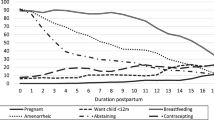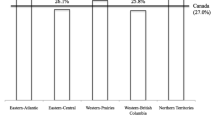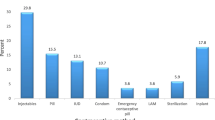Abstract
Objectives
We examined the relationship between unintended childbearing and knowledge of emergency contraception.
Methods
The Oregon Pregnancy Risk Assessment Monitoring System (PRAMS) is a population-based survey of postpartum women. We analyzed data from the 2001 PRAMS survey using logistic regression to assess the relationship between unintended childbearing and emergency contraception while controlling for maternal characteristics such as age, race/ethnicity, education, marital status, family income, and insurance coverage before pregnancy.
Results
In 2001, 1,795 women completed the PRAMS survey (78.1% weighted response proportion). Of the women who completed the survey, 38.2% reported that their birth was unintended and 25.3% reported that they did not know about emergency contraception before pregnancy. Unintended childbearing was associated with a lack of knowledge of emergency contraception (OR 1.43, 95% CI 1.00, 2.05) after controlling for marital status and age.
Conclusions
Women in Oregon who were not aware of emergency contraception before pregnancy were more likely to have had an unintended birth when their marital status and age were taken into account. Unintended birth was more likely among women who were young, unmarried, lower income, and uninsured. Given that emergency contraception is now available over-the-counter in the US to women who are 18 years of age or older, age- and culturally-appropriate public health messages should be developed to expand women’s awareness of, dispel myths around, and encourage appropriate use of emergency contraception as a tool to help prevent unintended pregnancy and birth.
Similar content being viewed by others
References
Finer, L. B., & Henshaw, S. K. (2006). Disparities in rates of unintended pregnancy in the United States, 1994 and 2001. Perspectives on Sexual and Reproductive Health, 38(2), 90–96.
Brown S. S., & Eisenberg, L, Committee on Unintended Pregnancy, Division of Health Promotion and Disease Prevention, Institute of Medicine (1995). The best intentions: Unintended pregnancy and the well-being of children and families, Washington, D.C.
Hulsey, T. M., Laken, M., Miller, V., & Ager, J. (2000). The influence of attitudes about unintended pregnancy on use of prenatal and postpartum care. Journal of Perinatology, 20(8 Pt 1), 513–519.
Hulsey, T. M. (2001). Association between early prenatal care and mother’s intention of and desire for the pregnancy. Journal of Obstetric, Gynecologic, and Neonatal Nursing, 30(3), 275–282.
Joyce, T., Kaestner, R., & Korenman, S. (2000). The stability of pregnancy intentions and pregnancy-related maternal behaviors. Maternal and Child Health Journal, 4(3), 171–178.
Joyce, T. J., Kaestner, R., & Korenman, S. (2000). The effect of pregnancy intention on child development. Demography, 37(1), 83–94.
Kost, K., Landry, D. J., & Darroch, J. E. (1998). Predicting maternal behaviors during pregnancy: does intention status matter? Family Planning Perspectives, 30(2), 79–88.
Mayer, J. P. (1997). Unintended childbearing, maternal beliefs, and delay of prenatal care. Birth, 24(4), 247–252.
Naimi, T. S., Lipscomb, L. E., Brewer, R. D., & Gilbert, B. C. (2003). Binge drinking in the preconception period and the risk of unintended pregnancy: implications for women and their children. Pediatrics, 111(5 Part 2), 1136–1141.
Roberts, R. O., Yawn, B. P., Wickes, S. L., Field, C. S., Garretson, M., & Jacobsen, S. J. (1998). Barriers to prenatal care: factors associated with late initiation of care in a middle-class midwestern community. The Journal of Family Practice, 47(1), 53–61.
Alexander, G. R., & Korenbrot, C. C. (1995). The role of prenatal care in preventing low birth weight. The Future of Children, 5(1), 103–120.
Floyd, R. L., Rimer, B. K., Giovino, G. A., Mullen, P. D., & Sullivan, S. E. (1993). A review of smoking in pregnancy: effects on pregnancy outcomes and cessation efforts. Annual Review of Public Health, 14, 379–411.
Green-Raleigh, K., Lawrence, J. M., Chen, H., Devine, O., & Prue, C. (2005). Pregnancy planning status and health behaviors among nonpregnant women in a California managed health care organization. Perspectives on Sexual and Reproductive Health, 37(4), 179–183.
Hellerstedt, W. L., Pirie, P. L., Lando, H. A., Curry, S. J., McBride, C. M., Grothaus, L. C., & Nelson, J. C. (1998). Differences in preconceptional and prenatal behaviors in women with intended and unintended pregnancies. American Journal of Public Health, 88(4), 663–666.
King, J. C., & Fabro, S. (1983). Alcohol consumption and cigarette smoking: effect on pregnancy. Clinical Obstetrics and Gynecology, 26(2), 437–448.
Lincoln, R. (1986). Smoking and reproduction. Family Planning Perspectives, 18(2), 79–84.
Folic acid for the prevention of neural tube defects (1999) American Academy of Pediatrics. Committee on Genetics: Pediatrics, 104(2 Pt 1), 325–327.
Rosenberg, K. D., Gelow, J. M., & Sandoval, A. P. (2003). Pregnancy intendedness and the use of periconceptional folic acid. Pediatrics, 111(5 Part 2), 1142–1145.
Kost, K., Landry, D. J., & Darroch, J. E. (1998). The effects of pregnancy planning status on birth outcomes and infant care. Family Planning Perspectives, 30(5), 223–230.
Orr, S. T., Miller, C. A., James, S. A., & Babones, S. (2000). Unintended pregnancy and preterm birth. Paediatric and Perinatal Epidemiology, 14(4), 309–313.
Sharma, R., Synkewecz, C., Raggio, T., & Mattison, D. R. (1994). Intermediate variables as determinants of adverse pregnancy outcome in high-risk inner-city populations. Journal of the National Medical Association, 86(11), 857–860.
Forrest, J. D. (1994). Epidemiology of unintended pregnancy and contraceptive use. American Journal of Obstetrics and Gynecology, 170(5 Pt 2), 1485–1489.
Fortney, J. A., Feldblum, P. J., & Raymond, E. G. (1999). Intrauterine devices. The optimal long-term contraceptive method? The Journal of Reproductive Medicine, 44(3), 269–274.
Frye, C. A. (2006). An overview of oral contraceptives: mechanism of action and clinical use. Neurology, 66(6 Suppl 3), S29–S36.
Gilliam, M. L., & Derman, R. J. (2000). Barrier methods of contraception. Obstetrics and Gynecology Clinics of North America, 27(4), 841–858.
Mills, A. (1984). Barrier contraception. Clinical Obstetrics and Gynecology, 11(3), 641–660.
Trussell, J., Stewart, F., Guest, F., & Hatcher, R. A. (1992). Emergency contraceptive pills: a simple proposal to reduce unintended pregnancies. Family Planning Perspectives, 24(6), 269–273.
Yuzpe, A. A. (1978). Postcoital contraception. International Journal of Gynaecology and Obstetrics, 16(6), 497–501.
Yuzpe, A. A. (1984). Postcoital contraception. Clinical Obstetrics and Gynecology, 11(3), 787–797.
von Hertzen, H., Piaggio, G., Ding, J., Chen, J., Song, S., Bartfai, G., Ng, E., Gemzell-Danielsson, K., Oyunbileg, A., Wu, S., Cheng, W., Ludicke, F., Pretnar-Darovec, A., Kirkman, R., Mittal, S., Khomassuridze, A., Apter, D., & Peregoudov, A. (2002). Low dose mifepristone and two regimens of levonorgestrel for emergency contraception: a WHO multicentre randomised trial. Lancet, 360(9348), 1803–1810.
Plan B©: Questions and Answers, August 24, 2006, and August 24, 2006, updated December 14, 2006. Rockville, MD: Department of Health and Human Services, U.S. food and drug administration, Center for drug evaluation and research, at http://www.fda.gov/cder/drug/infopage/planB/planBQandA20060824.htm and http://www.fda.gov/cder/drug/infopage/planB/planBQandA.htm. Accessed 03/18/07.
Abbott, J., Feldhaus, K. M., Houry, D., & Lowenstein, S. R. (2004). Emergency contraception: what do our patients know? Annals of Emergency Medicine, 43(3), 376–381.
Cohall, A. T., Dickerson, D., Vaughan, R., & Cohall, R. (1998). Inner-city adolescents’ awareness of emergency contraception. Journal of the American Medical Women’s Association, 53(5 Suppl 2), 258–261.
Conard, L. A., & Gold, M. A. (2004). Emergency contraceptive pills: a review of the recent literature. Current Opinion in Obstetrics & Gynecology, 16(5), 389–395.
Fagan, E. B., Boussios, H. E., Moore, R., & Galvin, S. L. (2006). Knowledge, attitudes, and use of emergency contraception among rural western North Carolina women. Southern Medical Journal, 99(8), 806–810.
Foster, D. G., Harper, C. C., Bley, J. J., Mikanda, J. J., Induni M., Saviano, E. C., & Stewart, F. H. (2004). Knowledge of emergency contraception among women aged 18 to 44 in California. American Journal of Obstetrics and Gynecology, 191(1), 150–156.
Jackson, R., Bimla Schwarz, E., Freedman, L., & Darney, P. (2000). Knowledge and willingness to use emergency contraception among low-income post-partum women. Contraception, 61(6), 351–357.
Jamieson, M. A., Hertweck, S. P., & Sanfilippo, J. S. (1999). Emergency contraception: lack of awareness among patients presenting for pregnancy termination. Journal of Pediatric and Adolescent Gynecology, 12(1), 11–15.
Delbanco, S. F., Mauldon, J., & Smith, M. D. (1997). Little knowledge and limited practice: emergency contraceptive pills, the public, and the obstetrician-gynecologist. Obstetrics and Gynecology, 89(6), 1006–1011.
Delbanco, S. F., Stewart, F. H., Koenig, J. D., Parker, M. L., Hoff, T., & McIntosh, M. (1998). Are we making progress with emergency contraception? Recent findings on American adults and health professionals. Journal of the American Medical Women’s Association, 53(5 Suppl 2), 242–246.
Oregon behavior risk surveillance system 2000 results. Portland, Oregon: Department of Human Services, Health Services, Center for Health Statistics and Vital Records, at: http://www.dhs.state.or.us/dhs/ph/chs/brfs/00/fepill.shtml. Accessed 03/18/07.
Aiken, A. M., Gold, M. A., & Parker, A. M. (2005). Changes in young women’s awareness, attitudes, and perceived barriers to using emergency contraception. Journal of Pediatric and Adolescent Gynecology, 18(1), 25–32.
Chuang, C. H., & Freund, K. M. (2005). Emergency contraception knowledge among women in a Boston community. Contraception, 71(2), 157–160.
Corbett, P. O., Mitchell, C. P., Taylor, J. S., & Kemppainen, J. (2006). Emergency contraception: knowledge and perceptions in a university population. Journal of the American Academy of Nurse Practitioners, 18(4), 161–168.
Harper, C., & Ellertson, C. (1995). Knowledge and perceptions of emergency contraceptive pills among a college-age population: a qualitative approach. Family Planning Perspectives, 27(4), 149–154.
Harper, C. C., & Ellertson, C. E. (1995). The emergency contraceptive pill: a survey of knowledge and attitudes among students at Princeton University. American Journal of Obstetrics and Gynecology, 173(5), 1438–1445.
Spence, M. R., Elgen, K. K., & Harwell, T. S. (2003). Awareness, prior use, and intent to use emergency contraception among Montana women at the time of pregnancy testing. Maternal and Child Health Journal, 7(3), 197–203.
Aquilino, M. L., & Losch, M. E. (2005). Across the fertility lifespan: desire for pregnancy at conception. MCN The American Journal of Maternal Child Nursing, 30(4), 256–262.
Beck, L. F., Morrow, B., Lipscomb, L. E., Johnson, C. H., Gaffield, M. E., Rogers, M., & Gilbert, B. C. (2002). Prevalence of selected maternal behaviors and experiences, Pregnancy Risk Assessment Monitoring System (PRAMS), 1999. MMWR Surveillance Summaries, 51(2), 1–27.
Dietz, P. M., Adams, M. M., Spitz, A. M., Morris, L., & Johnson, C. H. (1999). Live births resulting from unintended pregnancies: is there variation among states? The PRAMS Working Group. Family Planning Perspectives, 31(3), 132–136.
Forrest, J. D., & Singh, S. (1990). The sexual and reproductive behavior of American women, 1982–1988. Family Planning Perspectives, 22(5), 206–214.
Gazmararian, J. A., Adams, M. M., & Pamuk, E. R. (1996). Associations between measures of socioeconomic status and maternal health behavior. American Journal of Preventive Medicine, 12(2), 108–115.
Henshaw, S. K. (1998). Unintended pregnancy in the United States. Family Planning Perspectives, 30(1), 24–29.
Hopkins, R. S., Marshall, H., & Hoecherl, S. (1995). Medicaid costs of live births from unintended pregnancies in Florida. The Journal of the Florida Medical Association, 82(8), 540–543.
Kost, K., & Forrest, J. D. (1995). Intention status of U.S. births in 1988: differences by mothers’ socioeconomic and demographic characteristics. Family Planning Perspectives, 27(1), 11–17.
Rosenfeld, J. A., & Everett, K. D. (1996). Factors related to planned and unplanned pregnancies. The Journal of Family Practice, 43(2), 161–166.
Sable, M. R., Spencer, J. C., Stockbauer, J. W., Schramm, W. F., Howell, V., & Herman, A. A. (1997). Pregnancy wantedness and adverse pregnancy outcomes: differences by race and Medicaid status. Family Planning Perspectives, 29(2), 76–81.
Suellentrop, K., Morrow, B., Williams, L., & D’Angelo, D. (2006). Monitoring progress toward achieving Maternal and Infant Healthy People 2010 objectives–19 states, Pregnancy Risk Assessment Monitoring System (PRAMS), 2000–2003. MMWR Surveillance Summaries, 55(9), 1–11.
Williams, L. B. (1991). Determinants of unintended childbearing among ever-married women in the United States: 1973–1988. Family Planning Perspectives, 23(5), 212–215.
US Department of Health and Human Services, Office of Disease Prevention and Health Promotion, Healthy People 2010: Chapter 9: Family Planning. Washington, D.C.; 2000, at http://www.healthypeople.gov/Document/html/tracking/od09.htm. Accessed 03/18/07.
Oregon PRAMS First Year Report. (1998–1999). Portland, Oregon: Oregon Department of Human Services, Health Services, Office of Family Health, Portland, Oregon; 2000, at http://oregon.gov/DHS/ph/pnh/prams/9899/ar9899.shtml#append. Accessed 03/18/07.
Hodge, J. G., Gostin, L. O., with the Council of State and Territorial Epidemiologists Advisory Committee. (2004). Public health practice vs. research: A report for public health practitioners including cases and guidance for making distinctions. Atlanta, Georgia, at www.cste.org/pdffiles/newpdffiles/CSTEPHResRptHodgeFinal.2.24.04.pdf. Accessed 06/07/06.
Mosher, W. D., & Bachrach, C. A. (1996). Understanding US fertility: continuity and change in the National Survey of Family Growth, 1988–1995. Family Planning Perspectives, 28(1), 4–12.
Mosher, W. D. (1998). Design and operation of the 1995 National Survey of Family Growth. Family Planning Perspectives, 30(1), 43–46.
Korn, E. L., & Graubard, B. I. (1990). Simultaneous testing of regression coefficients with complex survey data: Use of Bonferroni t statistics. American Statistician, 79, 270–276.
Rao, C. R. (1973). Linear statistical inference and its application (2nd ed.). New York: Wiley, Inc.
Thomas, D. R., & Rao, J. N. K. (1987). Small-sample comparisons of level and power for simple goodness-of-fit statistics under cluster sampling. Journal of the American Statistical Association, 82, 630–636.
Hosmer, D.W., & Lemeshow, S. (2000). Applied logistic regression (2nd ed.). New York: John Wiley & Sons, Inc.
Trussell, J., Bull, J., Koenig, J., Bass, M., Allina, A., & Gamble, V. N. (1998). Call 1–888-NOT-2-LATE: promoting emergency contraception in the United States. Journal of the American Medical Women’s Association, 53(5 Suppl 2), 247–250.
Trussell, J., Koenig, J., Vaughan, B., & Stewart, F. (2001). Evaluation of a media campaign to increase knowledge about emergency contraception. Contraception, 63(2), 81–87.
The emergency contraception website. Princeton, NJ: The Office of Population Research, at http://ec.princeton.edu/. Accessed 03/18/07; Back Up Your Birth Control. New York, NY: Institute for Reproductive Health Access, NARAL Pro-Choice New York, at http://www.backupyourbirthcontrol.org/. Accessed 03/18/07.
Gardner, J. S., Hutchings, J., Fuller, T. S., & Downing, D. (2001). Increasing access to emergency contraception through community pharmacies: lessons from Washington State. Family Planning Perspectives, 33(4), 172–175.
Hayes, M., Hutchings, J., & Hayes, P. (2000). Reducing unintended pregnancy by increasing access to emergency contraceptive pills. Maternal and Child Health Journal, 4(3), 203–208.
Weldin, M., Hutchings, J., Hayes, M., McAllister, S., Harris, C., & Larsen-Mills, D. (2006). Expanding access to emergency contraception through state systems: the Washington State experience. Perspectives on Sex Reproductive Health, 38(4), 220–224.
Lowell, A., & Mobley, A. (2002). Emergency contraception promotion project report. Portland, Oregon: Population Services International, Portland, Oregon.
ACOG news release: ACOG Steps up efforts to get emergency contraception to women. Washington, DC: American College of Obstetricians and Gynecologists, at http://www.acog.org/from_home/publications/press_releases/nr05-08-06-1.cfm . Accessed 03/18/07.
Plan B© Repackaged for over-the-counter sales in pharmacies spurs grassroots effort to ensure women have access to this safe, effective birth control. Washington, DC: NARAL Pro-Choice America, at http://www.prochoiceamerica.org/news/press-releases/2006/pr11132006_planb.html. Accessed 03/18/07.
Whitehead, N., Shulman, H., & The PRAMS Working Group (1998). Mode of administration bias in a mixed mode survey. Maternal, infant, and child health epidemiology workshop: at http://www.uic.edu/sph/dataskills/liveconf/slideshows/ser/SER1/tsld001.htm. Accessed 03/18/07.
Bachrach, C. A., & Newcomer, S. (1999). Intended pregnancies and unintended pregnancies: distinct categories or opposite ends of a continuum? Family Planning Perspectives, 31(5), 251–252.
Cheng, L., Gülmezoglu, A. M., Van Oel, C. J., Piaggio, G., Ezcurra, E., Van Look, P. F. A. (2004). Interventions for emergency contraception. The Cochrane Database of systematic reviews, Issue 3. Art. No.: CD001324. DOI: 10.1002/14651858.CD001324.pub2.
Ellertson, C., Evans, M., Ferden, S., Leadbetter, C., Spears, A., Johnstone, K., & Trussell, J. (2003). Extending the time limit for starting the Yuzpe regimen of emergency contraception to 120 h. Obstetrics and Gynecology, 101(6), 1168–1171.
Glasier, A., Fairhurst, K., Wyke, S., Ziebland, S., Seaman, P., Walker, J., & Lakha, F. (2004). Advanced provision of emergency contraception does not reduce abortion rates. Contraception, 69(5), 361–366.
Raine, T. R., Harper, C. C., Rocca, C. H., Fischer, R., Padian, N., Klausner, J. D., & Darney, P. D. (2005). Direct access to emergency contraception through pharmacies and effect on unintended pregnancy and STIs: a randomized controlled trial. Journal of the American Medical Association, 293(1), 54–62.
Raymond, E. G., Stewart, F., Weaver, M., Monteith, C., & Van Der, P. B. (2006). Impact of increased access to emergency contraceptive pills: a randomized controlled trial. Obstetrics and Gynecology, 108(5), 1098–1106.
Raymond, E. G., Trussell, J., & Polis, C. B. (2007). Population effect of increased access to emergency contraceptive pills: A systematic review. Obstetrics and Gynecology, 109(1), 181–188.
Acknowledgments
We thank Tina Kent for her work on Oregon PRAMS. We also thank the Maternal and Child Health Bureau of the Health Resources and Services Administration and the Centers for Disease Control and Prevention for their support of Oregon PRAMS.
Author information
Authors and Affiliations
Corresponding author
Additional information
An erratum to this article can be found at http://dx.doi.org/10.1007/s10995-007-0282-4
Rights and permissions
About this article
Cite this article
Goldsmith, K.A., Kasehagen, L.J., Rosenberg, K.D. et al. Unintended Childbearing and Knowledge of Emergency Contraception in a Population-Based Survey of Postpartum Women. Matern Child Health J 12, 332–341 (2008). https://doi.org/10.1007/s10995-007-0252-x
Received:
Accepted:
Published:
Issue Date:
DOI: https://doi.org/10.1007/s10995-007-0252-x




